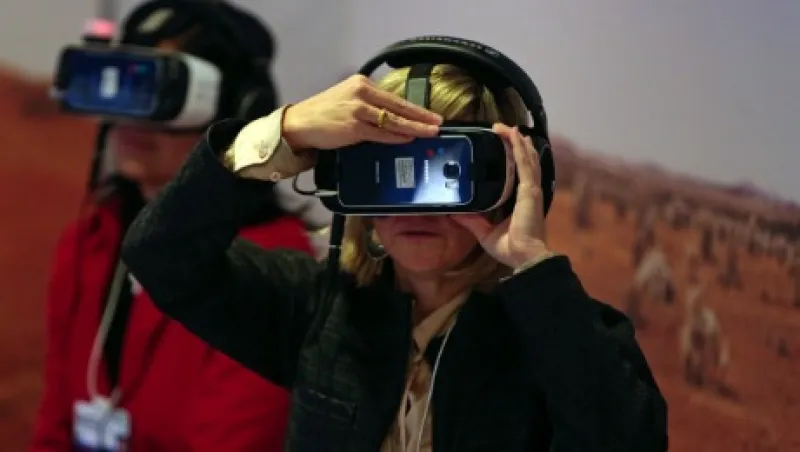Having finally made it through all those year-end top-ten lists — featuring giddy optimism for what the 12 months ahead hold for tech — we see one theme stands above the others: 2016 will be the year virtual reality (VR) becomes a household technology. Facebook’s long-awaited Oculus Rift headset will finally hit the market this year, and VR will grow, according to Goldman Sachs, into an $80 billion industry. Thanks to virtual reality and augmented reality (AR), excitement is brewing about real opportunities to craft new universes and explore our collective past and future. We can only hope we won’t waste our time on too many shoot-outs, explosions, murders and blizzards once we get this new reality.
In fact, we might be most curious about something other than VR’s capability to shock and entertain us. What can VR and AR do for our minds? How will these tools help us learn? Will they change human cognitive abilities moving forward? And, most important, how will savvy investors learn to spot the best opportunities in a shifting, protean field?
We can say for sure that VR is here to stay: Last year The New York Times announced its intent to deliver regular VR content, partnering with Google to send Cardboard VR viewers to subscribers in the hopes that 3-D coverage would be more compelling. We can feel relatively certain that once we begin to consume VR stories our minds and our habits will change. We might begin to realize that we already think in three dimensions, or that abstraction, logic and narrative — our primary tools for thought — can work more effectively and creatively in 3-D than on paper or a screen.
You can’t look at the end-of-year lists without finding a mention of Oculus; VR is mainstreaming, and soon. The behemoth, founded by the world’s greatest VR nerd, Palmer Luckey, will launch its Rift headset and controllers this spring, which may mean another win for the publicly traded Zuckerberg empire. Oculus’s Gear VR already pairs with the Samsung Galaxy 6 smartphone, cementing Facebook’s commitment to VR and AR media.
Where else might one look? The Vive headset is produced by Taiwan-based HTC in partnership with Bellevue, Washington–based Valve Corp. (producer of the world’s largest online gaming platform) and was a big hit at the Consumer Electronics show in Las Vegas in January. Vive was recently cleared by the Federal Communications Commission and is scheduled to launch in April. And, as pointed out by investing blog the Motley Fool a few months ago, consumers using the Oculus Rift will need Windows PCs with top-of-the-line graphics cards, which could give a boost to two Silicon Valley chipmakers: Santa Clara–based Nvidia and its Sunnyvale neighbor AMD.
Many virtual reality start-ups have graduated from Silicon Valley incubators like Y Combinator — but especially interesting is a more VR-specific incubator called River. Backed by Rothenberg Ventures, River has guided start-ups like San Francisco–based Emergent VR, which raised $2.2 million in venture funding last fall to build a virtual reality mobile platform. Some of these companies, including a small outfit called Solirax, have declared that VR’s greatest potential is for job training, vicarious learning and teaching.
Solirax is made up of a usual team of pathbreakers, including Tomáš (Frooxius) Mariancík, who built the VR engine Frooxengine. The company focuses explicitly on developing a VR universe in which users can create and play, allowing them to visualize ideas in 3-D in real time. Its gambit is that there is no better way to experience and learn about the world than in 3-D, as in its interactive NeoVR universe, set for release early this year. There’s always a chance that Solirax will be folded into a larger company, the way that LucasArts and eventually Pixar disappeared, or appended to Oculus itself, which we can’t forget already belongs to Facebook.
Virtual reality will help us learn through believable role-playing in Crystal Island and other VR environments being developed directly by researchers, as well as through virtual field trips like those being built by the VR team at Google. We can certainly expect to see VR used increasingly in education, and not just in technical training (it’s already used in the military and in aviation for that purpose). Much of human life is spent learning not just intellectual and physical skills but also emotional (thus work on new meditation VR apps) and social skills. By playing a character in a VR game, children can safely learn empathy and resilience — the same as they might by reading storybooks but much more quickly and, so-to-speak, convincingly. (Some of the same tech is already appearing in voice-activated interactive toys that can talk to children.)
Whatever happens with any of this technology, however, the best use of our energy will always be the same: curiosity, thoughtfulness and cooperation. If virtual reality opens new avenues to thinking well, together, then it will have done its work, just like any other technology we’ve ever had. That being said, it still might just be incredible to see what director James Cameron can do with fully immersive 3-D.






